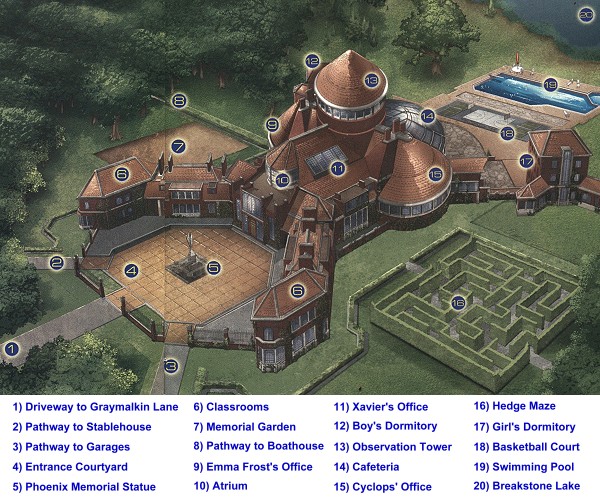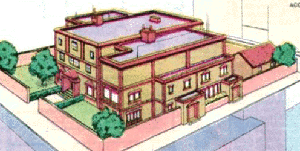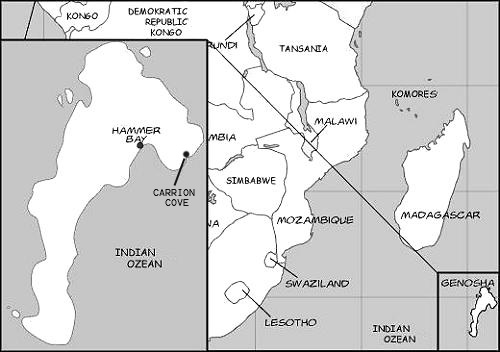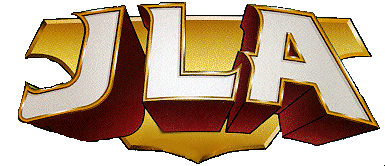 |

Thread for Locations, locations, locations
| Index | New Thread | Reply | Close | Stick | Delete | | Locations, locations, locations |
Sabine
9:29pm, May 20, 2006
[Edit]
[Delete] | This thread is going to be for links and pictures for all the areas of the Marvel/DC verse.
If you have a link that will be beneficial to this thread, please submit it to me via PM or over IM. It will be reviewed and if usable, shall be added to the appropriate thread.
Edited 4:30pm, May 20, 2006 by Sabine, author. |
| Xavier Institute for Higher Learning |
Sabine
9:37pm, May 20, 2006
[Edit]
[Delete] | There is an official canon curfew for All students at the Mansion. It is 10:00 PM.
Xavier Institute Resource
New Xavier Mansion Layout
More Mansion Info

Edited 12:31am, June 06, 2006 by Sabine, author. |
| Gotham City |
Sabine
9:38pm, May 20, 2006
[Edit]
[Delete] | Wikipedia on Gotham City

Gotham City
History
According to Swamp Thing #53 (and various subsequent comic book stories), Gotham City was founded in 1635 by a Swedish mercenary and was later taken over by the Kingdom of Great Britain. This loosely mirrors the history of New York, which was founded by the Dutch and taken over by the British. During the American Revolutionary War it was the site of a major battle and various occult rites were rumored to have been conducted within the city. Perhaps for these reasons Gotham is a dark and forbidding place rife with crime, grime, and corruption. Despite this, Gotham City has maintained a thriving economy and is considered a major economic center of activity.
Architecture
The unique architecture of Gotham City can be traced back to Judge Solomon Wayne during the pre-American Civil War era. Wayne's entrepreneurial skills made him a leading citizen in Gotham, starting a dozen businesses including the Gotham Buggy Whip Works. His campaign to reform Gotham came to a head when he met Cyrus Pinkney, a young architect looking for a commission. After the promotion of Pinkney's designs in the Property Holders Association, Wayne commissioned the first "Gotham Style" structures to be built in what is now the center of the city's financial district. Despite mixed reviews from critics, the Gothic architecture became a focal point for a thriving commercial center. Wayne and Pinkney would raise a dozen similar buildings in the years that followed, as Gotham took on a new face that would make it famous the world over.
GCPD and corruption
In addition to rampant organized crime activity in the city, the Gotham City Police Department (GCPD) was steeped in corruption up until the late 1980s. The strongest blow against police corruption came in 1986, when an increasing amount of conspiracy charges, arranged by the intervention of the mysterious Batman, against Commissioner Gillian Loeb forced him to resign his position. The Falcone crime family, which had had a stranglehold on Gotham's underground for generations, finally crumbled by the end of the 1980s, when a series of killings shook the structure of the mafia organization. After the death of Carmine Falcone in 1988, the Mafia lashed out in sloppy, retaliatory crimes, which, in combination with rising gang violence, severely crippled organized crime in Gotham City. Simultaneously, the ebbing presence of corrupt police officers allowed James Gordon to become the new commissioner, a man determined to eradicate crime wherever it existed.
Arkham Asylum
Main article: Arkham Asylum
Numerous costumed maniacs have emerged, necessitating the construction of an asylum dedicated to the incarceration of the criminally insane (called Arkham Asylum in homage to the fictional city of Arkham, Massachusetts in the works of H. P. Lovecraft, whose stories often included forbidding and decrepit New England cities with histories of occult practices and other evils). The origins of the asylum have been traced back to 1920, when psychiatrist Amadeus Arkham converted his estate into a mental health institution. Dr. Arkham studied under Carl Jung, interviewed Aleister Crowley during a trip to Europe and pioneered several key concepts in criminal psychology. Unfortunately, a series of personal tragedies caused Dr. Arkham's mental deterioration. At the start of the Great Depression in 1929, Amadeus was incarcerated for assaulting his stock broker. He died years later, imprisoned in the asylum he created. His nephew, Jeremiah Arkham, currently runs the asylum, and oversaw its reconstruction in 1992, and its movement to the Mercey House in 1995. Unfortunately the asylum has rarely managed to cure or keep its various insane inmates for long.
Recent events
In the late 1990s, Gotham City suffered from an artificially created epidemic, and was given its most devastating blow when an earthquake (measuring 7.6 on the Richter Scale) struck the city in 1998, resulting in untold property damage and, according to Adventures of Superman # 648, 5,057 dead at last recorded count. After much political controversy, a federal edict cut off the city from the rest of the United States, with most of Gotham's residents evacuating in the process. After a full year as a federally proclaimed "no man's land," the reconstruction of the city was initiated by privately owned businesses, and later taken over by the Federal Works Projects. Old landmarks were painstakingly restored or recreated in tribute to the city's rich history. New buildings were erected, in addition to the completion of the Gotham Rapid Transit System, which included the longest independently operated monorail system in the world. Gotham thus regained its identity, and remains today as one of the greatest cities in the world.
Additionally, James Gordon retired from service as Gotham's police commissioner. He currently is a law professor at Gotham University. He has been succeeded by the new police commissioner, Michael Akins. However, the status quo was recently restored during the One Year Later event, and James Gordon is now once again Commissioner, serving his third stint in the position.
Edited 12:15pm, June 05, 2006 by Sabine, author. |
| New York City |
Sabine
9:38pm, May 20, 2006
[Edit]
[Delete] | New York City in Comic Verse


Edited 6:55pm, May 21, 2006 by Sabine, author. |
| Metropolis |
Sabine
9:43pm, May 20, 2006
[Edit]
[Delete] | Metropolis



Metropolis City
Features
Over the years, Metropolis' features have greatly changed in the comics; however, Metropolis is always presented as being a world class city on the same caliber as New York City or Chicago, Illinois. It is often referred to as The Big Apricot just as New York City is nicknamed as The Big Apple.
Metropolis' features became more defined (and more obviously based on New York) following both 1985's Crisis on Infinite Earths miniseries and John Byrne's subsequent revamping of Superman, including the late 1980s comic special The World of Metropolis. Metropolis is presently divided into six regions or "boroughs", centered around "New Troy", an island borough based on Manhattan. The Daily Planet building, the most recognizable landmark in Metropolis, is located here (in "Planet Square"), as was Lex Luthor's corporate headquarters, the Lexcorp Tower. The now-married Clark Kent and Lois Lane currently live in an apartment in New Troy, at 1938 Sullivan Lane (a tribute to the year Superman first appeared); Clark Kent's traditional apartment address of 344 Clinton St., Apt. #3B, was usually described as being located in midtown Metropolis.
New Troy is separated from the suburban boroughs by the West River and Hobb's River. Jimmy Olsen lives in the borough of Bakerline, north of downtown. There is also an economically depressed area in northwestern New Troy called Suicide Slum, best known for the 1940s adventures of the Guardian and his street urchin companions, the Newsboy Legion. Although the northwestern location is similar to the relationship of Harlem to midtown Manhattan, the neighborhood bears more physical and cultural resemblance to Manhattan's Lower East Side.
A statue of Superman can be found in Centennial Park, Metropolis' largest park, based on New York's Central Park.
Other major media located in Metropolis include WGBS-TV, flagship station of the Galaxy Broadcasting System (GBS) television network, both subsidiaries of media conglomerate Galaxy Communications. Popular shows included The Midnight Show Starring Johnny Nevada (a fictional version of NBC's The Tonight Show, with Johnny Nevada being an analogue of Johnny Carson). During the 1970s, both Clark Kent and Lois Lane worked for WGBS (after Galaxy Communications purchased the Daily Planet in a 1971 storyline), with Clark as the anchorman for the WGBS evening news (he was eventually joined by Lana Lang as a co-anchor). After John Byrne's revamp of Superman's origins, though, Clark and Lois were reverted to working at the Daily Planet once again.
In the Silver Age comics, another major Metropolis landmark was the Superman Museum, which featured various exhibits dedicated to Metropolis' favorite superhero.
The central branch of S.T.A.R. Labs, a major scientific research institution, is located in Metropolis.
Metropolis' police department also possesses a special crimes unit dedicated to defending the city against superhuman menaces in case Superman is absent. The unit is headed by Maggie Sawyer and Dan Turpin, with both maintaining frequent contact with the Man of Steel. Another of Superman's police contacts over the years has been Inspector William Henderson, who in the current comics is the Metropolis police commissioner.
Around 2000, the city was given a futuristic makeover by the time-traveling Brainiac 13, a villainous descendant of Superman foe Brainiac. The transformation of Metropolis was covered in greater depth by the 2003 miniseries Superman: Metropolis. The city has since reverted to its former state.
The people of Metropolis are depicted as a diverse group of large city-dwellers, befitting Metropolis being (within the comics) one of the country's largest and most important cities outside of New York.
Notable areas, landmarks, institutions and businesses
Major facets of Metropolis as seen in the Superman comics include:
Ace o' Clubs: a bar owned by Bibbo Bibbowski in Suicide Slum.
Bessolo Boulevard: Metropolis' version of Broadway in New York City (its counterpart in Gotham City is called Grand Avenue). The name is derived from The Adventures of Superman lead actor George Reeves' middle name. Other Metropolis boulevards in the New Troy borough are similarly named for other actors from that series and from its radio predecessor of the same name(e.g.: Coates, Larson, Collyer, etc.).
Centennial Park: Metropolis' largest city park; its most noteworthy feature is a statue of Superman. A statue of Superboy has been added in the wake of the events of Infinite Crisis.
The Daily Planet building: the most recognizable landmark in the Metropolis skyline, particularly for the Daily Planet globe atop the building. The Daily Planet is one of the most renowned news organizations in the DC Universe.
Glenmorgan Square: one of a number of New Troy's counterparts to New York's Times Square.
LexCorp headquarters: the main base of operations for Lex Luthor's company.
Suicide Slum: an impoverished and crime infested neighborhood in Metropolis.
WGBS-TV: the flagship television station of the Galaxy Broadcasting System television network.
Edited 8:38pm, June 26, 2006 by Sabine, author. |
| Avengers Mansion |
Sabine
9:46pm, May 20, 2006
[Edit]
[Delete] | The Avengers Mansion


Edited 6:23pm, May 21, 2006 by Sabine, author. |
| Baxter Building |
Sabine
9:47pm, May 20, 2006
[Edit]
[Delete] | The Baxter Building


Edited 6:08pm, May 21, 2006 by Sabine, author. |
| Genosha |
Sabine
9:48pm, May 20, 2006
[Edit]
[Delete] | Wikipedia on Genosha

Edited 6:10pm, May 21, 2006 by Sabine, author. |
| Latveria |
Sabine
9:49pm, May 20, 2006
[Edit]
[Delete] | Latveria: A Tourist's Guide
Latveria
Wikipedia on Latveria

Edited 6:09pm, May 21, 2006 by Sabine, author. |
| |
Duck Sauce
8:34am, June 03, 2006
[Edit]
[Delete] | Someone's been busy...
Nice work Sabi, even for a gimp ;) :P |
| The Justice League of America |
Sabine
11:20pm, June 05, 2006
[Edit]
[Delete] | 

Main View
1. Solar Tower
2. Observation Deck
3. Laboratory Building
4. Armory
5. Steel's Workshop
6. Hall of Justice
7. Monitor Womb
8. Hydroponic forests
9. Aquaman deep water tanks (connected via tunnels to surface pool)
10. Teleporters
11. Reception
12. Secure Facility
13. Living quarters
14. Bulk teleport hangar
Exterior Structures:
3a. Research Lab
3b. Medical Lab
3c. Martian Jumpship shuttle hangar
13a. Lounge
13b. Kitchen
13c. Dining area
Cross-Section
15. Engineering control
16. Trophy Room
17. Villain Gallery
18. Games/Recreation/Simulators
19. Gymnasium/Saunas
20. Pool (connected to deep water tank)
21. Park
22. Private teleporters
23. Air control
24. Tunnels to shuttle bay
25. Stairs to lower levels
The JLA Watchtower
The Watchtower is the name of various bases used by the Justice League of America in DC Comics and various other media. It has been portrayed, in DC comics as a building on the moon and as a space-station in orbit, in the Justice League Unlimited cartoon.
The Watchtower debuted in JLA # 4 during Grant Morrison's run on the title. It is constructed of Promethium (the DC Universe's equivilant of Marvel's Adamantium) and uses Earthly and Martian technology. The arrival of Orion and Big Barda added New Genesis technology to the systems within.
Areas of the Watchtower was shown in JLA # 16 when super-villain Prometheus made his debut and downloaded the Watchtower blueprints. Among them:
"The Hall of Justice" - housed atop the Watchtowers' peak is the conference hall where the League meets and plots strategy, assigns duties and engages in open discussion. At its center a round table, a nod to Camelot's Knights of the Round Table. There are 12 seats, 7 or 8 of which are reserved for the core members with their respective insignia. The JLA symbol itself is prominently placed in the center of the table.
Promenade - a large area devoted for ceremonies (as seen when Aztek was inaugurated as a member) as well as a place to assemble a large contingent of superheroes in cases of extreme necessity.
Monitor Womb - the heart of the Watchtower, stretching the entire center of the complex. It houses the Leagues' vast computer/communications/sensor network. All crisis points are detected through this circular chamber with multiple holographic displays. Although monitor duty is assigned in a revolving system, Martian Manhunter often volunteers for this as his great telepathic powers are uniquely attuned to the Martian technology (similar to Charles Xavier using Cerebro.)
Trophy Room - various memorabilia from the League's past cases as well as sculptures/tributes to fallen heroes. Some notable memorabilia include Green Arrow's trick arrows, Booster Gold's armor, Kanjar Ro's Gamma Gong, various alien weapons/gadgets, galleries of past League rosters among others.
Armory/Hangar - adjacent to one another, this area houses a variety of specialized equipment the League or its allies may need depending on the mission as well as space-worthy ships capable of intergalactic travel.
Hydrophonics - this area houses a variety of alien flora which has greatly efficient photosynthesis compared to terran plants, serving as the Watchtower's source of Oxygen.
Aquarium - serves as Aquaman's private quarters as well as housing marine life from other worlds.
Private quarters - each core member has a specific private quarters for extended stays. Individual quarters are personalized for the members' tastes and lifestyle (such as Wonder Woman's Greek-themed quarters or Martian Manhunter's meditation chamber). Additional guest quarters are available as well.
Other areas: Power Core, Recreation area, Holographic training room, Laboratories, Med-lab, Technology/Engineering Workshops, Containment Cells.
Getting to the Watchtower and around the various areas is facilitated by Teleportation tubes placed for easy access in the event of an emergency.
Edited 6:21pm, June 05, 2006 by Sabine, author. |
| Titan Tower(s) |
Sabine
5:16am, June 06, 2006
[Edit]
[Delete] | 
Titan Tower - San Fransisco
Third tower
The current Titans Tower is located in San Francisco Bay. It was again designed by Cyborg, and was built by the city council, in exchange for which the Titans are responsible for dealing with the city's supervillains.
The outside of the tower features a sculpture commemorating the founders of the Titans, Robin, Kid Flash, Aqualad, Wonder Girl, and Speedy. While the sculpture appeared to crumble in Infinite Crisis #5, Teen Titans (v3) #33 depicted the sculpture still standing.
Memorial
The current tower houses a memorial for fallen Titans. It contains statues of almost all of the dead Titans, including those who had served with the team very briefly. However, it did not include Phantasm, Gnaark, or Jason Todd, who were also Titans for a very short period of time.
In Teen Titans (v3) #29, Jason Todd entered Titans Tower and fought Tim Drake, the current Robin. The fight spread throughout the tower and eventually led to Jason finding the memorial. Angered at himself not having a statue (despite inclusion of other brief Titans such as Kole), he destroyed Donna Troy's statue. In issue #30, Jericho's statue was destroyed likewise. Ironically, both of these characters had returned from the dead in one way or another since the current series began.
The following Titans were memorialized:
Aquagirl (Tula)
Dove (Don Hall)
Golden Eagle
Hawk (Hank Hall)
Jericho (statue destroyed, alive but stored in an electronic drive)
Kole
Omen
Terra
Troia (statue destroyed, recently resurrected)
Infinite Crisis
Spoiler warning: Plot and/or ending details follow.
It is yet unknown if any of the destroyed statues will be repaired, or if new statues will be added for the recently deceased Titans who died during Infinite Crisis, listed below.
The following former Titans have been killed over the course of Infinite Crisis:
Baby Wildebeest
Bushido
Pantha
Superboy
Several other Titans have disappeared and their current statuses are not known.
One Year Later
A statue of Superboy, who died during Infinite Crisis, has been placed outside Titans Tower, in addition to his memorial in Metropolis.
The Hall of Mentors
In Teen Titans (v3) #17, the Titans traveled to the future where an additional wing was added to the tower featuring a "Hall of Mentors" with statues of the mentors of the Titans. It featured Max Mercury for Kid Flash, Ares for Wonder Girl, Superman and Lex Luthor for Superboy, and a destroyed statue of Batman for Robin. It also features statues for Geo-Force and Green Arrow.
The Hall of Mentors will be featured in a future issue of Teen Titans (v3)[1]. It will also have a statue of Blue Devil as the mentor of Kid Devil who will have joined the team since then.
Edited 8:43pm, June 26, 2006 by Sabine, author. |
| Index | New Thread | Reply | Close | Stick | Delete |

|
 |
|



